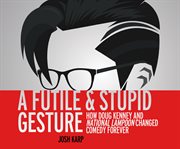Review by Choice Review
Born in Chagrin Falls, OH, Kenney graduated from Harvard, where the patrician humor magazine Harvard Lampoon (founded 1876) launched his career. Having helped make the college publication wildly irreverent and take it national, Kenney cowrote its film spawn, Animal House and Caddyshack, which shifted American popular comedy into the exuberant countercultural spirit of the 1970s. Despite his fame and remarkable fortune, Kenney was disheartened by the latter film and disappeared in Hawaii, where he was found dead from either a fall or a jump. Karp's biography teems with funny stories about the precocious wag and his now-famous associates (P. J. O'Rourke, John Belushi, Chevy Chase, et al.). Those who squirm at the messy lives of Kenney and his pals will find ample recompense in the old comic material Karp includes. For all his research and zip, though, Karp tips his hand when he declares Chagrin Falls "prosaically named." ^BSumming Up: Recommended. Lower-/upper-division undergraduates, general readers. M. Yacowar formerly, University of Calgary
Copyright American Library Association, used with permission.
Review by Booklist Review
When Doug Kenney, Henry Beard, and a handful of other Harvard Lampoonalums launched National Lampoon, one of their dreams was to create a long-lived American humor magazine to match Britain's venerable Punch. But for a few ill-advised business and creative decisions, they might have succeeded. Instead NL first transformed early-1970s anti-authoritarianism into lively, intelligent humor, then devolved into a formulaic, low-brow, mildly reactionary rag with a predilection for T&A and body--function jokes. Kenney shepherded NL through its first years, writing first-rate satire, before stumbling through a series of personal crises ended by a mysterious, perhaps suicidal, fall to his death in Hawaii in 1980. Both Karp's well-researched analysis of why NL succeeded, shuddered, and ultimately crashed and his biography of Kenney are compelling, and the latter is also mysterious. Early success in the magazine world and later in Hollywood (Kenney had a hand in Animal House and Caddyshack) only seemed to make Kenney more miserable. Karp's account of Kenney's death is as moving as the excerpts from excellent NL articles are hilarious. --Jack Helbig Copyright 2006 Booklist
From Booklist, Copyright (c) American Library Association. Used with permission.
Review by Publisher's Weekly Review
Screenwriter Kenney (Animal House; Caddyshack), co-founder of National Lampoon, was one of the gifted gagsters who ignited the 1970s revolution in American humor. Journalist Karp (Playboy; Premiere) delivers an iridescent, polychromatic portrait of the humorist, framed within an amusing anecdotal history of National Lampoon. To chart the magazine's rise and fall, Karp conducted 150 interviews, mapping every avenue of business decisions, feuds, romances, cocaine use and bizarre pranks. It all began at Harvard, where wild wit Kenney and misanthropic Henry Beard became "symbiotic creative forces," revitalizing the Harvard Lampoon. When they teamed with publisher Matty Simmons, National Lampoon was born in 1970, filling the "gigantic void" between the New Yorker and Mad. Success led to heightened hilarity as the brand expanded with posters, products, theatrical productions and recordings. The 1973 National Lampoon Radio Hour cast resurfaced in 1975 on Saturday Night Live, but the anarchic Animal House in 1978 catapulted Kenney to Hollywood-as Karp writes, "He had transformed himself from nerd to preppy to hippie and now to unassuming millionaire artiste." 16-page b&w photo insert not seen by PW. (Sept. 1) (c) Copyright PWxyz, LLC. All rights reserved
(c) Copyright PWxyz, LLC. All rights reserved
Review by Library Journal Review
For the multitude of baby boomers coming into full adolescent bloom in the 1970s, the National Lampoon was the cat's ass. With comedic masterpieces like the 1964 Kefauver High School Yearbook parody and the transcendent January 1973 cover of the buy-this-magazine-or-we'll-shoot-this-dog issue, the Lampoon imprinted American popular culture forever. The Harvard-educated mastermind behind the Lampoon, as well as the movies Animal House and Caddyshack, was Doug Kenney, whose story and intersections with other star-crossed geniuses like Michael O'Donoghue, John Belushi, Chevy Chase, and P.J. O'Rourke are wonderfully told in this interview-driven, behind-the-scenes account. Readers are immersed in the comedy scene in 1970s New York City as well as the birth of the Lampoon and its spin-off media. Karp, an experienced journalist, conducted 150 interviews, so it's understandable that the story's cadence is at times more staccato than fluid. Like a cultural joyride in a 1975 Cutlass 442-fun, fast, and furious. Larger public and academic libraries should purchase.-Barry X. Miller, Austin P.L., TX (c) Copyright 2010. Library Journals LLC, a wholly owned subsidiary of Media Source, Inc. No redistribution permitted.
(c) Copyright Library Journals LLC, a wholly owned subsidiary of Media Source, Inc. No redistribution permitted.

